Enhanced Monitoring of Sub-Seasonal Land Use Dynamics in Vietnam’s Mekong Delta through Quantile Mapping and Harmonic Regression
Abstract
1. Introduction
2. Study Area
3. Data Basis
3.1. Satellite Data
3.2. LULC Class Determination
3.3. Reference Data Collection for Validation
4. Materials and Methods
4.1. Sentinel-2 Cloud Masking
4.2. Calculation of Multi-Temporal Metrics
4.2.1. Quantile Mapping
4.2.2. Harmonic Analysis
4.2.3. Phenological, Hydrological, and Built-Up Metrics
4.2.4. Sentinel-1 Composite
4.3. LULC Classification Based on Time Series Features
5. Results
5.1. Classification Result
5.2. Input Metric Evaluation
6. Discussion
6.1. Redundancy of Input Metric Information
6.2. Key Contributions of Quantile Mapping, Harmonic Regression, and Radar Data
7. Conclusions
Author Contributions
Funding
Data Availability Statement
Acknowledgments
Conflicts of Interest
Abbreviations
| CTU | Can Tho University |
| EVI | Enhanced Vegetation Index |
| ML | Machine Learning |
| MRD | Mekong River Delta |
| NDBI | Normalized Difference Built-up Index |
| NDVI | Normalized Difference Vegetation Index |
| NDWI | Normalized Difference Water Index |
| SA-AW | Summer–Autumn—Autumn–Winter |
| SIPI | Structure Insensitive Pigment Index |
| VARI | Visible Atmospherically Resistant Index |
| WS-SA | Winter–Spring—Summer–Autumn |
Appendix A
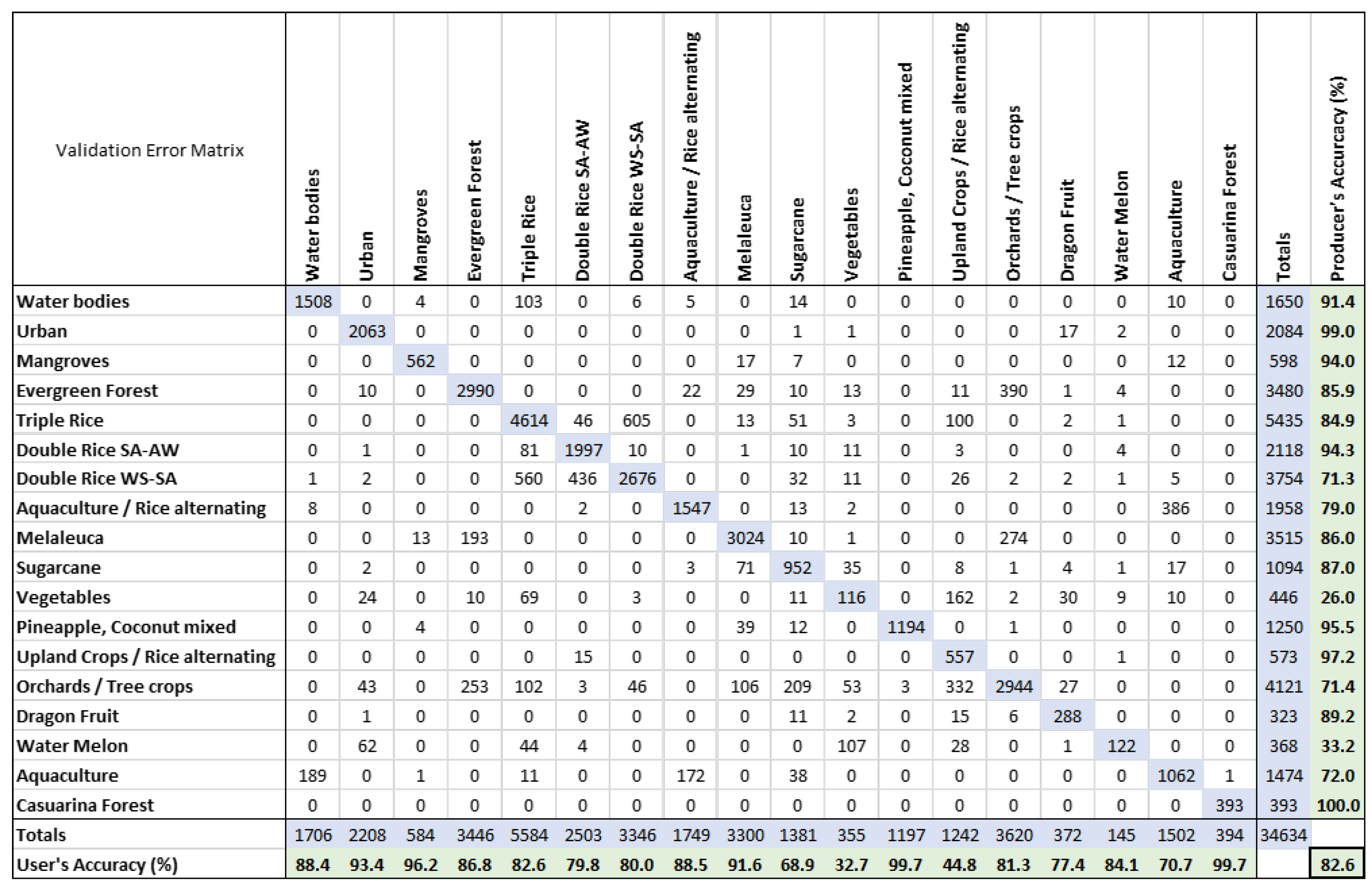

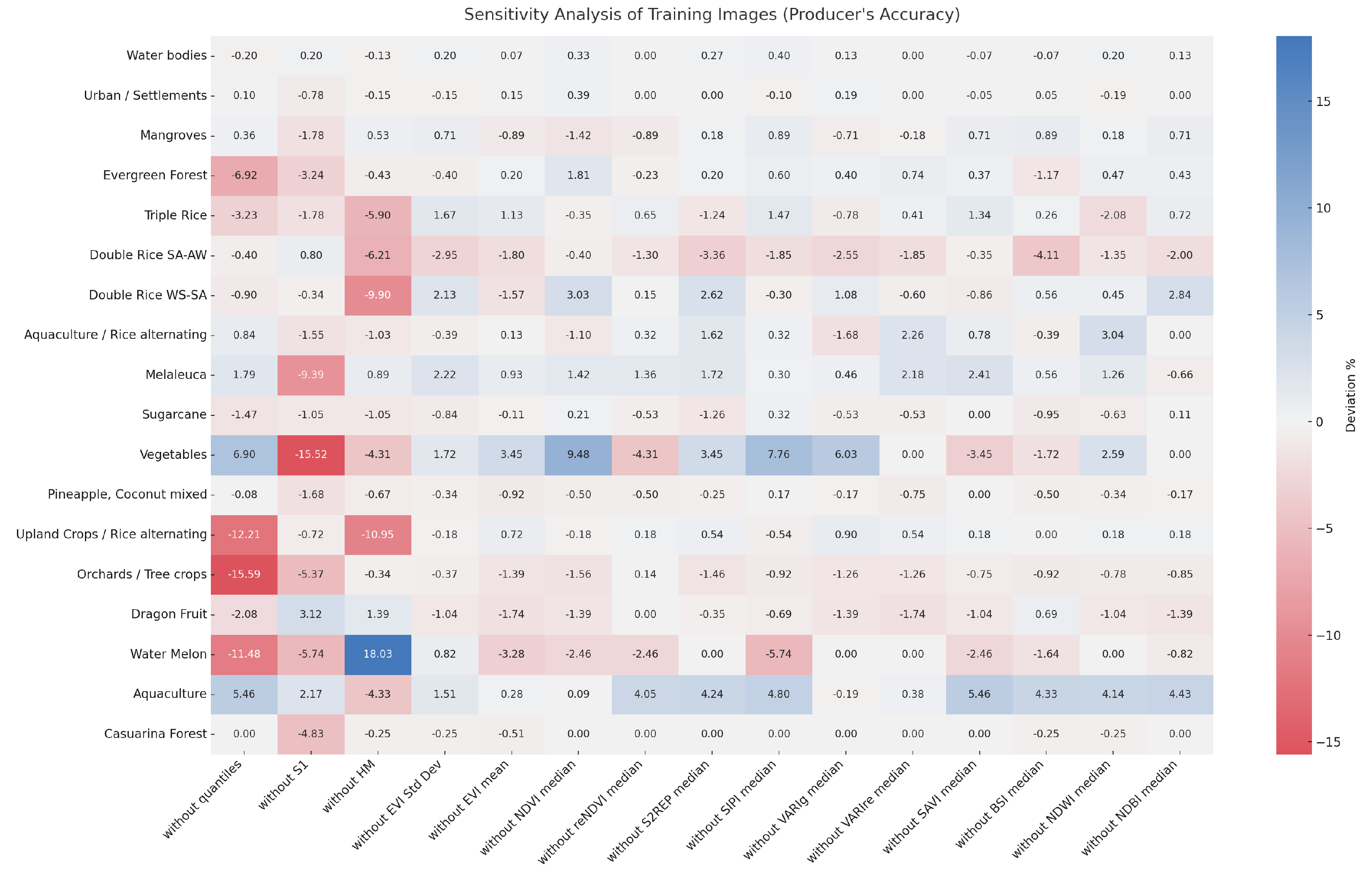
References
- Dawe, D.; Pandey, S.; Nelson, A.D. Emerging trends and spatial patterns of rice production. In Rice in the Global Economy: Strategic Research and Policy Issues for Food Security; Pandey, S., Byerlee, D., Dawe, D., Dobermann, A., Mohanty, S., Rozelle, S., Hardy, B., Eds.; International Rice Research Institute: Los Banos, Philippines, 2010; Chapter 1.1; pp. 15–35. [Google Scholar]
- Leinenkugel, P.; Kuenzer, C.; Oppelt, N.; Dech, S. Characterisation of land surface phenology and land cover based on moderate resolution satellite data in cloud prone areas—A novel product for the Mekong Basin. Remote. Sens. Environ. 2013, 136, 180–198. [Google Scholar] [CrossRef]
- Vu, H.T.D.; Tran, D.D.; Schenk, A.; Nguyen, C.P.; Vu, H.L.; Oberle, P.; Trinh, V.C.; Nestmann, F. Land use change in the Vietnamese Mekong Delta: New evidence from remote sensing. Sci. Total Environ. 2022, 813, 151918. [Google Scholar] [CrossRef] [PubMed]
- Mondal, A.; Le, M.H.; Lakshmi, V. Land use, climate, and water change in the Vietnamese Mekong Delta (VMD) using earth observation and hydrological modeling. J. Hydrol. Reg. Stud. 2022, 42, 101132. [Google Scholar] [CrossRef]
- Phan, H.; Toan, T.L.; Bouvet, A. Understanding dense time series of sentinel-1 backscatter from rice fields: Case study in a province of the mekong delta, Vietnam. Remote Sens. 2021, 13, 921. [Google Scholar] [CrossRef]
- Pham, L.H.; Pham, L.T.; Dang, T.D.; Tran, D.D.; Dinh, T.Q. Application of Sentinel-1 data in mapping land-use and land cover in a complex seasonal landscape: A case study in coastal area of Vietnamese Mekong Delta. Geocarto Int. 2022, 37, 3743–3760. [Google Scholar] [CrossRef]
- Sakamoto, T.; Van Nguyen, N.; Ohno, H.; Ishitsuka, N.; Yokozawa, M. Spatio-temporal distribution of rice phenology and cropping systems in the Mekong Delta with special reference to the seasonal water flow of the Mekong and Bassac rivers. Remote Sens. Environ. 2006, 100, 1–16. [Google Scholar] [CrossRef]
- Sakamoto, T.; Cao Van, P.; Kotera, A.; Nguyen Duy, K.; Yokozawa, M. Detection of yearly change in farming systems in the Vietnamese Mekong Delta from MODIS time-series imagery. Jpn. Agric. Res. Q. 2009, 43, 173–185. [Google Scholar] [CrossRef]
- Sakamoto, T.; Van Phung, C.; Kotera, A.; Nguyen, K.D.; Yokozawa, M. Analysis of rapid expansion of inland aquaculture and triple rice-cropping areas in a coastal area of the Vietnamese Mekong Delta using MODIS time-series imagery. Landsc. Urban Plan. 2009, 92, 34–46. [Google Scholar] [CrossRef]
- Chen, C.F.; Son, N.T.; Chang, L.Y.; Chen, C.R. Classification of rice cropping systems by empirical mode decomposition and linear mixture model for time-series MODIS 250 m NDVI data in the Mekong Delta, Vietnam. Int. J. Remote. Sens. 2011, 32, 5115–5134. [Google Scholar] [CrossRef]
- Chen, C.F.; Son, N.T.; Chang, L.Y.; Chen, C.C. Monitoring of soil moisture variability in relation to rice cropping systems in the Vietnamese Mekong Delta using MODIS data. Appl. Geogr. 2011, 31, 463–475. [Google Scholar] [CrossRef]
- Chen, C.F.; Son, N.T.; Chang, L.Y. Monitoring of rice cropping intensity in the upper Mekong Delta, Vietnam using time-series MODIS data. Adv. Space Res. 2012, 49, 292–301. [Google Scholar] [CrossRef]
- Son, N.T.; Chen, C.F.; Chen, C.R.; Duc, H.N.; Chang, L.Y. A phenology-based classification of time-series MODIS data for rice crop monitoring in Mekong Delta, Vietnam. Remote Sens. 2013, 6, 135–156. [Google Scholar] [CrossRef]
- Son, N.T.; Chen, C.F.; Chen, C.R.; Minh, V.Q.; Trung, N.H. A comparative analysis of multitemporal MODIS EVI and NDVI data for large-scale rice yield estimation. Agric. For. Meteorol. 2014, 197, 52–64. [Google Scholar] [CrossRef]
- Guan, X.; Huang, C.; Liu, G.; Meng, X.; Liu, Q. Mapping rice cropping systems in Vietnam using an NDVI-based time-series similarity measurement based on DTW distance. Remote Sens. 2016, 8, 19–44. [Google Scholar] [CrossRef]
- Scarrott, R. Extracting Gradient Boundaries Using Hyper-Temporal Image Analysis: Progress towards a Tool for Gradient Analysts. Master’s Thesis, University of Twente, Enschede, The Netherlands, 2009. [Google Scholar]
- Nguyen, T.T.H.; De Bie, C.A.J.M.; Ali, A.; Smaling, E.M.A.; Chu, T.H. Mapping the irrigated rice cropping patterns of the Mekong delta, Vietnam, through hyper-temporal SPOT NDVI image analysis. Int. J. Remote Sens. 2012, 33, 415–434. [Google Scholar] [CrossRef]
- Karila, K.; Nevalainen, O.; Krooks, A.; Karjalainen, M.; Kaasalainen, S. Monitoring Changes in Rice Cultivated Area from SAR and Optical Satellite Images in Ben Tre and Tra Vinh Provinces in Mekong Delta, Vietnam. Remote Sens. 2014, 6, 4090–4108. [Google Scholar] [CrossRef]
- Bouvet, A.; Le Toan, T. Use of ENVISAT/ASAR wide-swath data for timely rice fields mapping in the Mekong River Delta. Remote Sens. Environ. 2011, 115, 1090–1101. [Google Scholar] [CrossRef]
- Nguyen, T.T.; Berg, H.; Nguyen, H.T.T.; Nguyen, C.V. Effects of chlorpyrifos ethyl on acetylcholinesterase activity in climbing perch cultured in rice fields in the Mekong Delta, Vietnam. Ecotoxicol. Environ. Saf. 2015, 117, 34–40. [Google Scholar] [CrossRef] [PubMed]
- Chen, C.F.; Son, N.T.; Chen, C.R.; Chang, L.Y.; Chiang, S.H. Rice crop mapping using Sentinel-1A phenological metrics. In Proceedings of the International Archives of the Photogrammetry, Remote Sensing and Spatial Information Sciences—ISPRS Archives, Prague, Czech Republic, 12–19 July 2016. [Google Scholar] [CrossRef]
- Clauss, K.; Ottinger, M.; Kuenzer, C. Mapping rice areas with Sentinel-1 time series and superpixel segmentation. Int. J. Remote Sens. 2018, 39, 1399–1420. [Google Scholar] [CrossRef]
- Phung, H.P.; Nguyen, L.D.; Thong, N.H.; Thuy, L.T.; Apan, A.A. Monitoring rice growth status in the Mekong Delta, Vietnam using multitemporal Sentinel-1 data. J. Appl. Remote Sens. 2020, 14, 014518. [Google Scholar] [CrossRef]
- Thu, P.M.; Populus, J. Status and changes of mangrove forest in Mekong Delta: Case study in Tra Vinh, Vietnam. Estuarine Coast. Shelf Sci. 2007, 71, 98–109. [Google Scholar] [CrossRef]
- Nguyen, H.H.; McAlpine, C.; Pullar, D.; Johansen, K.; Duke, N.C. The relationship of spatial-temporal changes in fringe mangrove extent and adjacent land-use: Case study of Kien Giang coast, Vietnam. Ocean. Coast. Manag. 2013, 76, 12–22. [Google Scholar] [CrossRef]
- Tran Thi, V.; Tien Thi Xuan, A.; Phan Nguyen, H.; Dahdouh-Guebas, F.; Koedam, N. Application of remote sensing and GIS for detection of long-term mangrove shoreline changes in Mui Ca Mau, Vietnam. Biogeosciences 2014, 11, 3781–3795. [Google Scholar] [CrossRef]
- Nardin, W.; Locatelli, S.; Pasquarella, V.; Rulli, M.C.; Woodcock, C.E.; Fagherazzi, S. Dynamics of a fringe mangrove forest detected by Landsat images in the Mekong River Delta, Vietnam. Earth Surf. Process. Landforms 2016, 41, 2024–2037. [Google Scholar] [CrossRef]
- Bullock, E.L.; Fagherazzi, S.; Nardin, W.; Vo-Luong, P.; Nguyen, P.; Woodcock, C.E. Temporal patterns in species zonation in a mangrove forest in the Mekong Delta, Vietnam, using a time series of Landsat imagery. Cont. Shelf Res. 2017, 147, 144–154. [Google Scholar] [CrossRef]
- Vo, Q.T.; Oppelt, N.; Leinenkugel, P.; Kuenzer, C. Remote sensing in mapping mangrove ecosystems—An object-based approach. Remote Sens. 2013, 5, 183–201. [Google Scholar] [CrossRef]
- Ottinger, M.; Clauss, K.; Kuenzer, C. Large-Scale Assessment of Coastal Aquaculture Ponds with Sentinel-1 Time Series Data. Remote Sens. 2017, 9, 440. [Google Scholar] [CrossRef]
- Son, N.T.; Tu, N.A. Determinants of land-use change: A case study from the lower Mekong delta of southern Vietnam. Electron. Green J. 2008, 1, 1–12. [Google Scholar] [CrossRef]
- Leinenkugel, P.; Wolters, M.L.; Oppelt, N.; Kuenzer, C. Tree cover and forest cover dynamics in the Mekong Basin from 2001 to 2011. Remote. Sens. Environ. 2015, 158, 376–392. [Google Scholar] [CrossRef]
- Kuenzer, C.; Guo, H.; Huth, J.; Leinenkugel, P.; Li, X.; Dech, S. Flood mapping and flood dynamics of the mekong delta: ENVISAT-ASAR-WSM based time series analyses. Remote Sens. 2013, 5, 687–715. [Google Scholar] [CrossRef]
- Van Khanh Triet, N.; Viet Dung, N.; Fujii, H.; Kummu, M.; Merz, B.; Apel, H. Has dyke development in the Vietnamese Mekong Delta shifted flood hazard downstream? Hydrol. Earth Syst. Sci. 2017, 21, 3991–4010. [Google Scholar] [CrossRef]
- Kuenzer, C.; Leinenkugel, P.; Vollmuth, M.; Dech, S. Comparing global land-cover products—Implications for geoscience applications: An investigation for the trans-boundary Mekong Basin. Int. J. Remote Sens. 2014, 35, 2752–2779. [Google Scholar] [CrossRef]
- Kuenzer, C.; Heimhuber, V.; Huth, J.; Dech, S. Remote sensing for the quantification of land surface dynamics in large river delta regions—A review. Remote Sens. 2019, 11, 1985. [Google Scholar] [CrossRef]
- Poortinga, A.; Aekakkararungroj, A.; Kityuttachai, K.; Nguyen, Q.; Bhandari, B.; Thwal, N.S.; Priestley, H.; Kim, J.; Tenneson, K.; Chishtie, F.; et al. Predictive analytics for identifying land cover change hotspots in the mekong region. Remote Sens. 2020, 12, 1472. [Google Scholar] [CrossRef]
- Funkenberg, T.; Binh, T.T.; Moder, F.; Dech, S. The Ha Tien Plain—Wetland monitoring using remote-sensing techniques. Int. J. Remote Sens. 2014, 35, 2893–2909. [Google Scholar] [CrossRef][Green Version]
- Nguyen, H.H.; Dargusch, P.; Moss, P.; Aziz, A.A. Land-use change and socio-ecological drivers of wetland conversion in Ha Tien Plain, Mekong Delta, Vietnam. Land Use Policy 2017, 64, 101–113. [Google Scholar] [CrossRef]
- Nguyen, H.; Pham Van, P.; Nguyen Thi Hong, D. Monitoring 15-year land use/land cover change in the Vietnamese Mekong Delta. Dong Thap Univ. J. Sci. 2022, 11, 93–103. [Google Scholar] [CrossRef]
- Liu, S.; Li, X.; Chen, D.; Duan, Y.; Ji, H.; Zhang, L.; Chai, Q.; Hu, X. Understanding Land use/Land cover dynamics and impacts of human activities in the Mekong Delta over the last 40 years. Glob. Ecol. Conserv. 2020, 22, e00991. [Google Scholar] [CrossRef]
- Dang, A.T.; Kumar, L.; Reid, M.; Nguyen, H. Remote sensing approach for monitoring coastal wetland in the mekong delta, vietnam: Change trends and their driving forces. Remote Sens. 2021, 13, 3359. [Google Scholar] [CrossRef]
- Gebhardt, S.; Nguyen, L.D.; Kuenzer, C. Mangrove Ecosystems in the Mekong Delta—Overcoming Uncertainties in Inventory Mapping Using Satellite Remote Sensing Data. In The Mekong Delta System: Interdisciplinary Analyses of a River Delta; Renaud, F.G., Kuenzer, C., Eds.; Springer: Dordrecht, The Netherlands, 2012. [Google Scholar] [CrossRef]
- Kuenzer, C.; Knauer, K. Remote sensing of rice crop areas. Int. J. Remote Sens. 2013, 34, 2101–2139. [Google Scholar] [CrossRef]
- Zhang, Y.; Xu, N.; Li, N.; Guo, Z. A Multi-Domain Joint Novel Method for ISAR Imaging of Multi-Ship Targets. Remote Sens. 2023, 15, 4878. [Google Scholar] [CrossRef]
- Chen, Y.; Lv, J.; Yue, W.; Zhao, Y.; Qin, Y.; Tao, J.; Chen, C.; Wang, W.; Liang, J. A Snapshot Infrared Imaging Fourier Transform Spectrometer for Dynamic Target Detection. Remote Sens. 2022, 14, 1543. [Google Scholar] [CrossRef]
- Mudiyanselage, S.D.; Wilkinson, B.; Abd-Elrahman, A. Automated High-Resolution Bathymetry from Sentinel-1 SAR Images in Deeper Nearshore Coastal Waters in Eastern Florida. Remote Sens. 2024, 16, 1. [Google Scholar] [CrossRef]
- Rocchini, D.; Metz, M.; Ricotta, C.; Landa, M.; Frigeri, A.; Neteler, M. Fourier transforms for detecting multitemporal landscape fragmentation by remote sensing. Int. J. Remote Sens. 2013, 34, 8907–8916. [Google Scholar] [CrossRef]
- Moody, A.; Johnson, D.M. Land-surface phenologies from AVHRR using the discrete Fourier transform. Remote Sens. Environ. 2001, 75, 305–323. [Google Scholar] [CrossRef]
- Melendez-Pastor, I.; Navarro-Pedreño, J.; Koch, M.; Gómez, I.; Hernández, E.I. Land-cover phenologies and their relation to climatic variables in an anthropogenically impacted mediterranean coastal area. Remote Sens. 2010, 2, 697–716. [Google Scholar] [CrossRef]
- Song, B.; Min, S.; Yang, H.; Wu, Y.; Wang, B. A Fourier Frequency Domain Convolutional Neural Network for Remote Sensing Crop Classification Considering Global Consistency and Edge Specificity. Remote Sens. 2023, 15, 4788. [Google Scholar] [CrossRef]
- Wen, L.; Mason, T.; Powell, M.; Ling, J.; Ryan, S.; Bernich, A.; Gufu, G. Improved Wetland Mapping of a Highly Fragmented Agricultural Landscape Using Land Surface Phenological Features. Remote Sens. 2024, 16, 1786. [Google Scholar] [CrossRef]
- Yang, F.; Liu, S.; Wang, Q.; Liu, T.; Li, S. Assessing waterlogging stress level of winter wheat from hyperspectral imagery based on harmonic analysis. Remote Sens. 2022, 14, 122. [Google Scholar] [CrossRef]
- Sobe, C.; Hirschmugl, M.; Wimmer, A. Sentinel-2 time series analysis for identification of underutilized land in europe. Remote Sens. 2021, 13, 4920. [Google Scholar] [CrossRef]
- Pastick, N.J.; Wylie, B.K.; Wu, Z. Spatiotemporal analysis of Landsat-8 and Sentinel-2 data to support monitoring of dryland ecosystems. Remote Sens. 2018, 10, 791. [Google Scholar] [CrossRef]
- Migolet, P.; Goïta, K. Evaluation of FORMOSAT-2 and planetscope imagery for aboveground oil palm biomass estimation in a mature plantation in the Congo Basin. Remote Sens. 2020, 12, 2926. [Google Scholar] [CrossRef]
- Nguyen, M.D.; Baez-Villanueva, O.M.; Bui, D.D.; Nguyen, P.T.; Ribbe, L. Harmonization of landsat and sentinel 2 for crop monitoring in drought prone areas: Case studies of Ninh Thuan (Vietnam) and Bekaa (Lebanon). Remote Sens. 2020, 12, 281. [Google Scholar] [CrossRef]
- Philipp, M.; Wegmann, M.; Kübert-Flock, C. Quantifying the response of german forests to drought events via satellite imagery. Remote Sens. 2021, 13, 1845. [Google Scholar] [CrossRef]
- Sato, M. Utilization of woody biomass in Southeast Asia: Melaleuca in the Mekong delta region. J. Agric. Dev. Stud. 2009, 20, 15–21. [Google Scholar]
- GSOV. General Statistics Office of Vietnam. Available online: https://www.gso.gov.vn/en/homepage/ (accessed on 27 April 2024).
- Kontgis, C.; Schneider, A.; Ozdogan, M. Mapping rice paddy extent and intensification in the Vietnamese Mekong River Delta with dense time stacks of Landsat data. Remote Sens. Environ. 2015, 169, 255–269. [Google Scholar] [CrossRef]
- Tong, Y.D. Rice Intensive Cropping and Balanced Cropping in the Mekong Delta, Vietnam—Economic and Ecological Considerations. Ecol. Econ. 2017, 132, 205–212. [Google Scholar] [CrossRef]
- Renaud, F.G.; Le, T.T.H.; Lindener, C.; Guong, V.T.; Sebesvari, Z. Resilience and shifts in agro-ecosystems facing increasing sea-level rise and salinity intrusion in Ben Tre Province, Mekong Delta. Clim. Chang. 2015, 133, 69–84. [Google Scholar] [CrossRef]
- Gorelick, N.; Hancher, M.; Dixon, M.; Ilyushchenko, S.; Thau, D.; Moore, R. Google Earth Engine: Planetary-scale geospatial analysis for everyone. Remote Sens. Environ. 2017, 202, 18–27. [Google Scholar] [CrossRef]
- Barroso, L.A.; Clidaras, J.; Hölzle, U. The Datacenter as a Computer: An Introduction to the Design of Warehouse-Scale Machines, 2nd ed.; Springer Nature: Cham, Switzerland, 2013; p. 154. [Google Scholar] [CrossRef]
- Earth Observation and Modeling Facility. Global Geo-Referenced Field Photo Library. 2013. Available online: https://www.ceom.ou.edu/photos/ (accessed on 20 September 2024).
- Congalton, R.G.; Green, K. Assessing the Accuracy of Remotely Sensed Data Principles and Practices, 3rd ed.; CRC Press: Boca Raton, FL, USA, 2019. [Google Scholar]
- Main-Knorn, M.; Pflug, B.; Louis, J.; Debaecker, V.; Müller-Wilm, U.; Gascon, F. Sen2Cor for Sentinel-2. In Proceedings of the Image and Signal Processing for Remote Sensing XXIII, Warsaw, Poland, 11–13 September 2017; p. 3. [Google Scholar] [CrossRef]
- Batič, M. Sentinel Hub Cloud Detector—s2cloudless. 2018. Available online: https://medium.com/sentinel-hub/sentinel-hub-cloud-detector-s2cloudless-a67d263d3025 (accessed on 14 July 2023).
- Skakun, S.; Wevers, J.; Brockmann, C.; Doxani, G.; Aleksandrov, M.; Batič, M.; Frantz, D.; Gascon, F.; Gómez-Chova, L.; Hagolle, O.; et al. Cloud Mask Intercomparison eXercise (CMIX): An evaluation of cloud masking algorithms for Landsat 8 and Sentinel-2. Remote Sens. Environ. 2022, 274, 112990. [Google Scholar] [CrossRef]
- Hollstein, A.; Segl, K.; Guanter, L.; Brell, M.; Enesco, M. Ready-to-use methods for the detection of clouds, cirrus, snow, shadow, water and clear sky pixels in Sentinel-2 MSI images. Remote Sens. 2016, 8, 666–684. [Google Scholar] [CrossRef]
- Griffiths, P.; Müller, D.; Kuemmerle, T.; Hostert, P. Agricultural land change in the Carpathian ecoregion after the breakdown of socialism and expansion of the European Union. Environ. Res. Lett. 2013, 8, 045024. [Google Scholar] [CrossRef]
- Hansen, M.; Potapov, P.; Moore, R.; Hancher, M.; Turubanova, S.; Tyukavina, A.; Thau, D.; Stehman, S.; Goetz, S.; Loveland, T.; et al. High-Resolution Global Maps of 21st-Century Forest Cover Change. Science 2013, 342, 850–853. [Google Scholar] [CrossRef] [PubMed]
- Müller, H.; Rufin, P.; Griffiths, P.; Barros Siqueira, A.J.; Hostert, P. Mining dense Landsat time series for separating cropland and pasture in a heterogeneous Brazilian savanna landscape. Remote Sens. Environ. 2015, 156, 490–499. [Google Scholar] [CrossRef]
- Rufin, P.; Müller, H.; Pflugmacher, D.; Hostert, P. Land use intensity trajectories on Amazonian pastures derived from Landsat time series. Int. J. Appl. Earth Obs. Geoinf. 2015, 41, 1–10. [Google Scholar] [CrossRef]
- Leinenkugel, P.; Wolters, M.L.; Kuenzer, C.; Oppelt, N.; Dech, S. Sensitivity analysis for predicting continuous fields of tree-cover and fractional land-cover distributions in cloud-prone areas. Int. J. Remote Sens. 2014, 35, 2799–2821. [Google Scholar] [CrossRef]
- Mack, B.; Leinenkugel, P.; Kuenzer, C.; Dech, S. A semi-automated approach for the generation of a new land use and land cover product for Germany based on Landsat time-series and Lucas in-situ data. Remote Sens. Lett. 2017, 8, 244–253. [Google Scholar] [CrossRef]
- Koenker, R. Quantile Regression; Cambridge University Press: Cambridge, UK, 2005. [Google Scholar]
- Li, X.; Wu, H.; Nanding, N.; Chen, S.; Hu, Y.; Li, L. Statistical Bias Correction of Precipitation Forecasts Based on Quantile Mapping on the Sub-Seasonal to Seasonal Scale. Remote Sens. 2023, 15, 1743. [Google Scholar] [CrossRef]
- Huang, Y.; Wu, C.; Chen, M.; Yang, J.; Ren, H. A quantile approach for retrieving the “core urban-suburban-rural” (USR) structure based on nighttime light. Remote Sens. 2020, 12, 4179. [Google Scholar] [CrossRef]
- Allen, A.W.; Cade, B.S.; Vandever, M.W. Effects of emergency haying on vegetative characteristics within selected conservation reserve program fields in the northern Great Plains. J. Soil Water Conserv. 2001, 56, 120–125. [Google Scholar]
- Zha, Y.; Gao, J.; Ni, S. Use of normalized difference built-up index in automatically mapping urban areas from TM imagery. Int. J. Remote. Sens. 2003, 24, 583–594. [Google Scholar] [CrossRef]
- Huete, A.; Didan, K.; Miura, T.; Rodriguez, E.P.; Gao, X.; Ferreira, L.G. Overview of the radiometric and biophysical performance of the MODIS vegetation indices. Remote Sens. Environ. 2002, 83, 195–213. [Google Scholar] [CrossRef]
- Jakubauskas, M.; Legates, D.; Kastens, J. Harmonic Analysis of Time-series AVHRR NDVI Data. Photogramm. Eng. Remote Sens. 2001, 67, 461–470. [Google Scholar]
- Jakubauskas, M.E.; Legates, D.R.; Kastens, J.H. Crop identification using harmonic analysis of time-series AVHRR NDVI data. Comput. Electron. Agric. 2002, 37, 127–139. [Google Scholar] [CrossRef]
- Shumway, R.H.; Stoffer, D.S. Time Series Analysis and Applications, 4th ed.; Springer: New York, NY, USA, 2016. [Google Scholar]
- Gitelson, A.A.; Kaufman, Y.J.; Stark, R.; Rundquist, D. Novel algorithms for remote estimation of vegetation fraction. Remote. Sens. Environ. 2002, 80, 76–87. [Google Scholar] [CrossRef]
- Penuelas, J.; Baret, F.; Filella, I. Semi-Empirical Indices to Assess Carotenoids/Chlorophyll-a Ratio from Leaf Spectral Reflectance. Photosynthetica 1995, 31, 221–230. [Google Scholar]
- Rouse, J.W.; Haas, R.H.; Schell, J.A.; Deering, D.W.; Harlan, J.C. Monitoring vegetation systems in the Great Plains with ERTS. In Proceedings of the Third ERTS Symposium, Washington, DC, USA, 10–14 December 1973; pp. 309–317. [Google Scholar]
- Delegido, J.; Verrelst, J.; Meza, C.M.; Rivera, J.P.; Alonso, L.; Moreno, J. A red-edge spectral index for remote sensing estimation of green LAI over agroecosystems. Eur. J. Agron. 2013, 46, 42–52. [Google Scholar] [CrossRef]
- Agapiou, A.; Lysandrou, V.; Hadjimitsis, D.G. Earth observation contribution to cultural heritage disaster risk management: Case study of eastern mediterranean open air archaeological monuments and sites. Remote Sens. 2020, 12, 1330. [Google Scholar] [CrossRef]
- Frampton, W.J.; Dash, J.; Watmough, G.; Milton, E.J. Evaluating the capabilities of Sentinel-2 for quantitative estimation of biophysical variables in vegetation. ISPRS J. Photogramm. Remote Sens. 2013, 82, 83–92. [Google Scholar] [CrossRef]
- Gao, B.C. NDWI—A normalized difference water index for remote sensing of vegetation liquid water from space. Remote Sens. Environ. 1996, 58, 257–266. [Google Scholar] [CrossRef]
- Hayes, M.M.; Miller, S.N.; Murphy, M.A. High-resolution landcover classification using random forest. Remote Sens. Lett. 2014, 5, 112–121. [Google Scholar] [CrossRef]

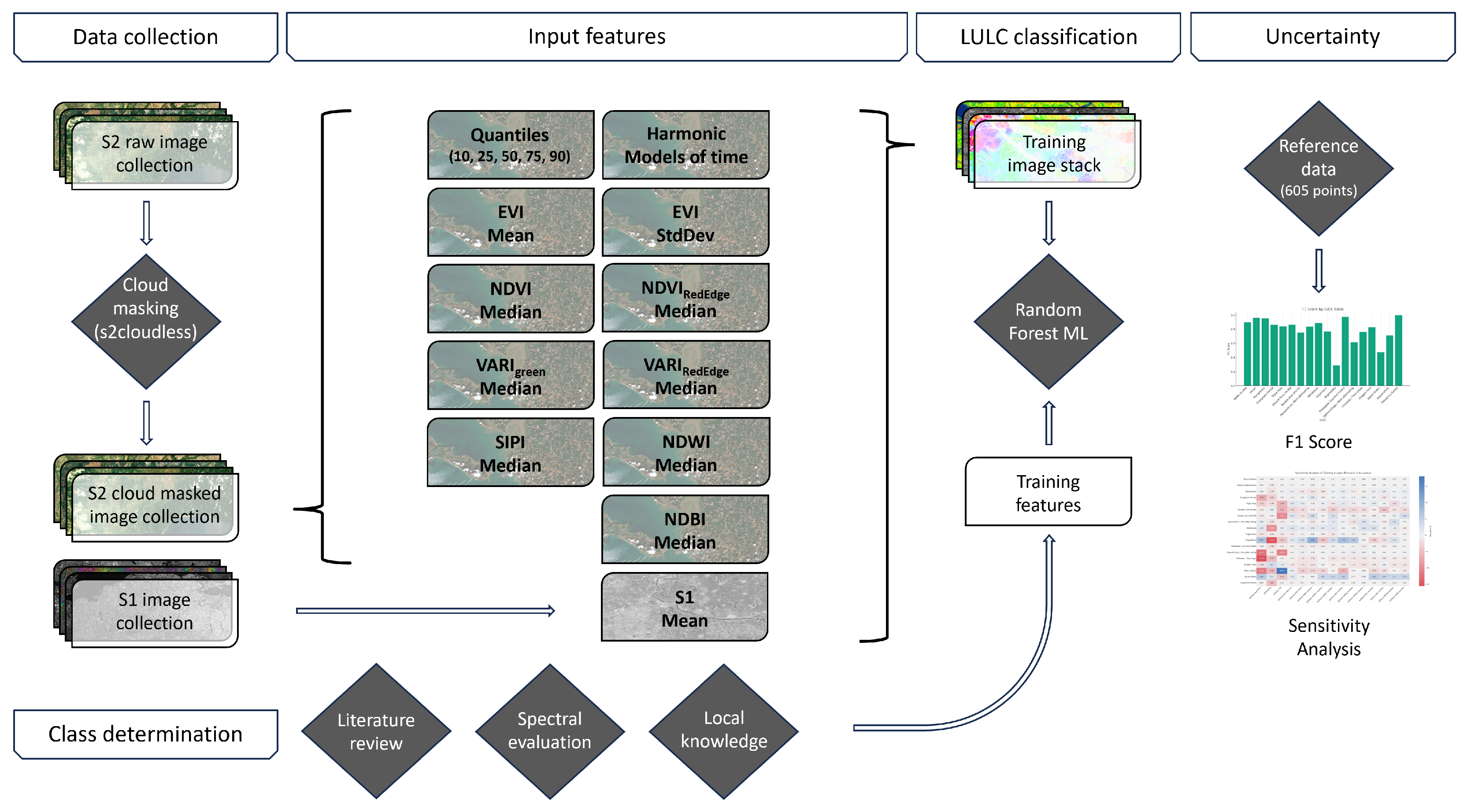
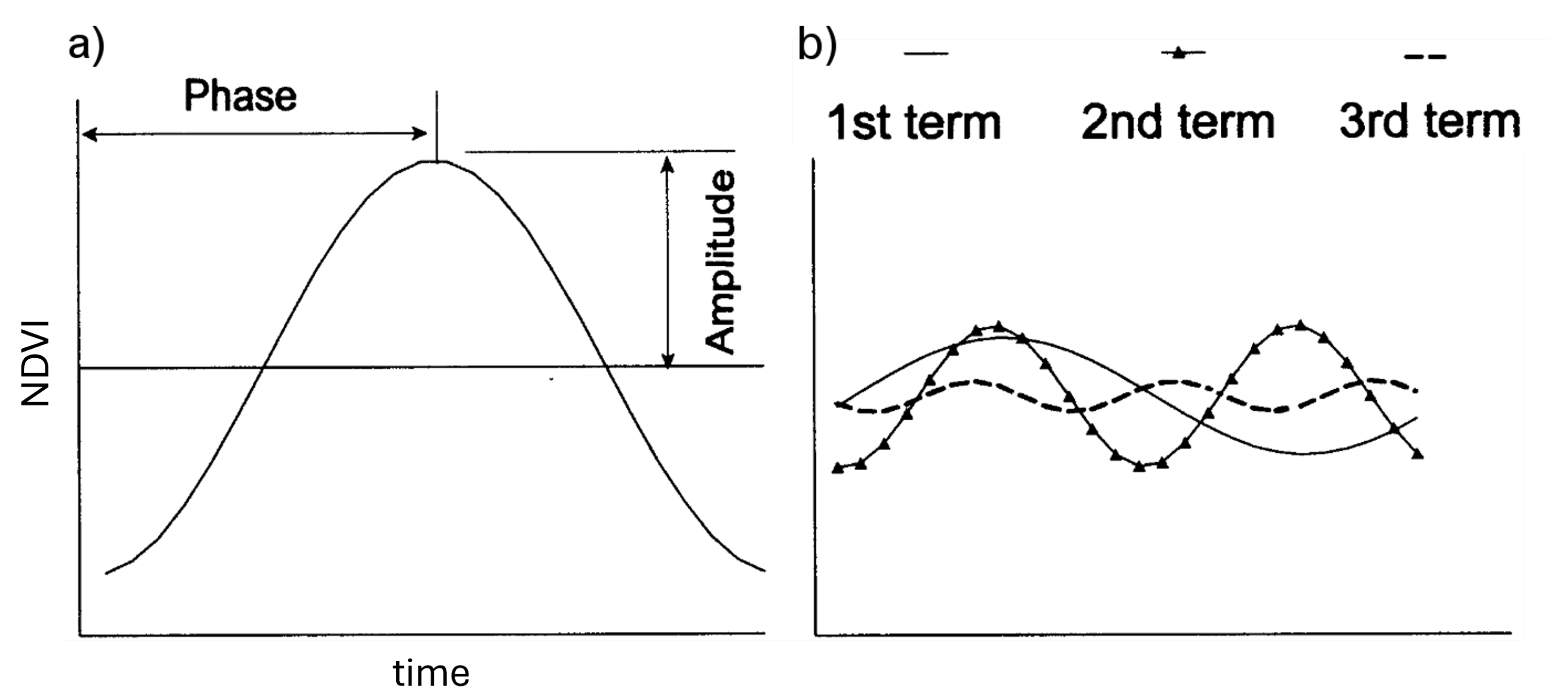
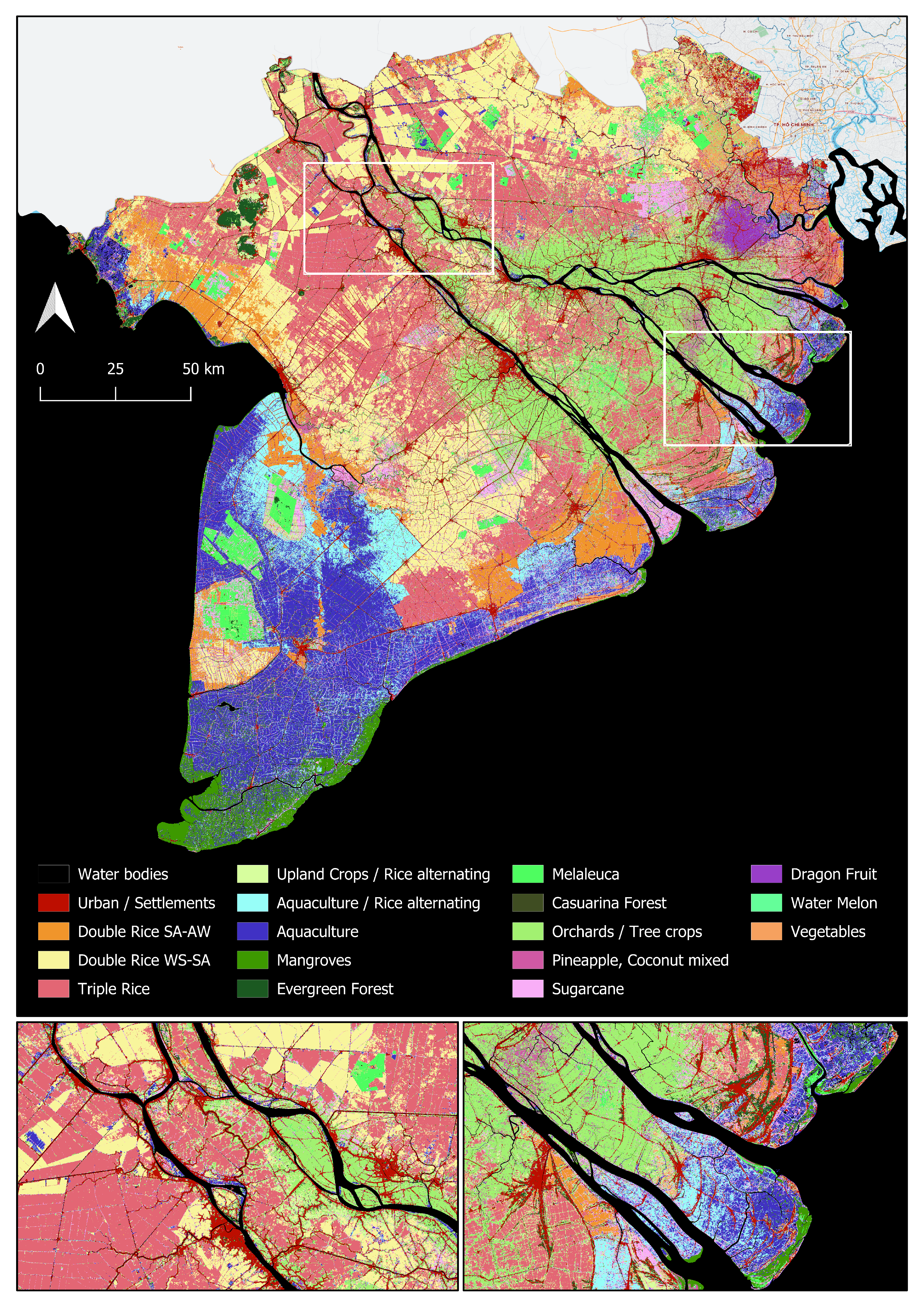

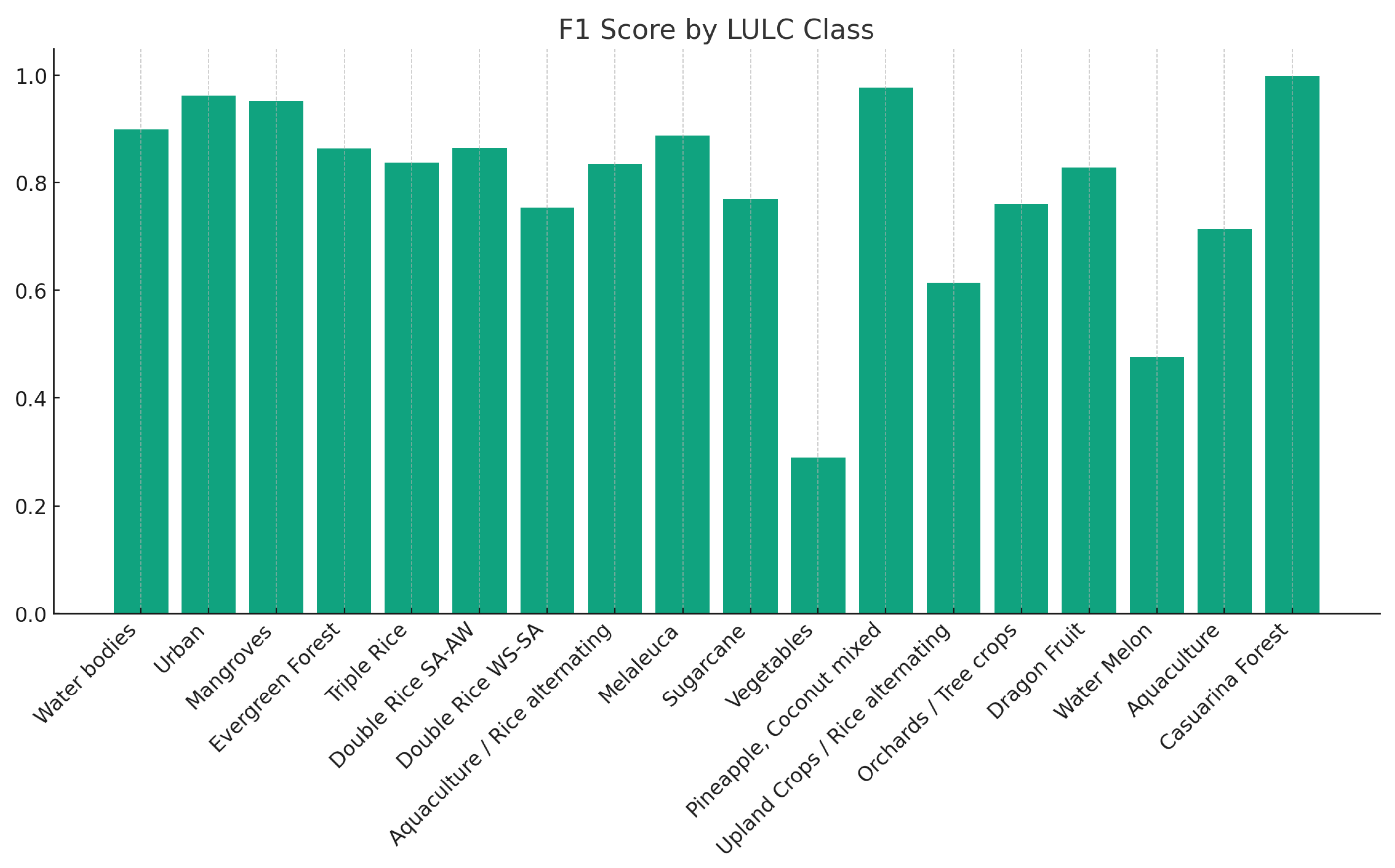
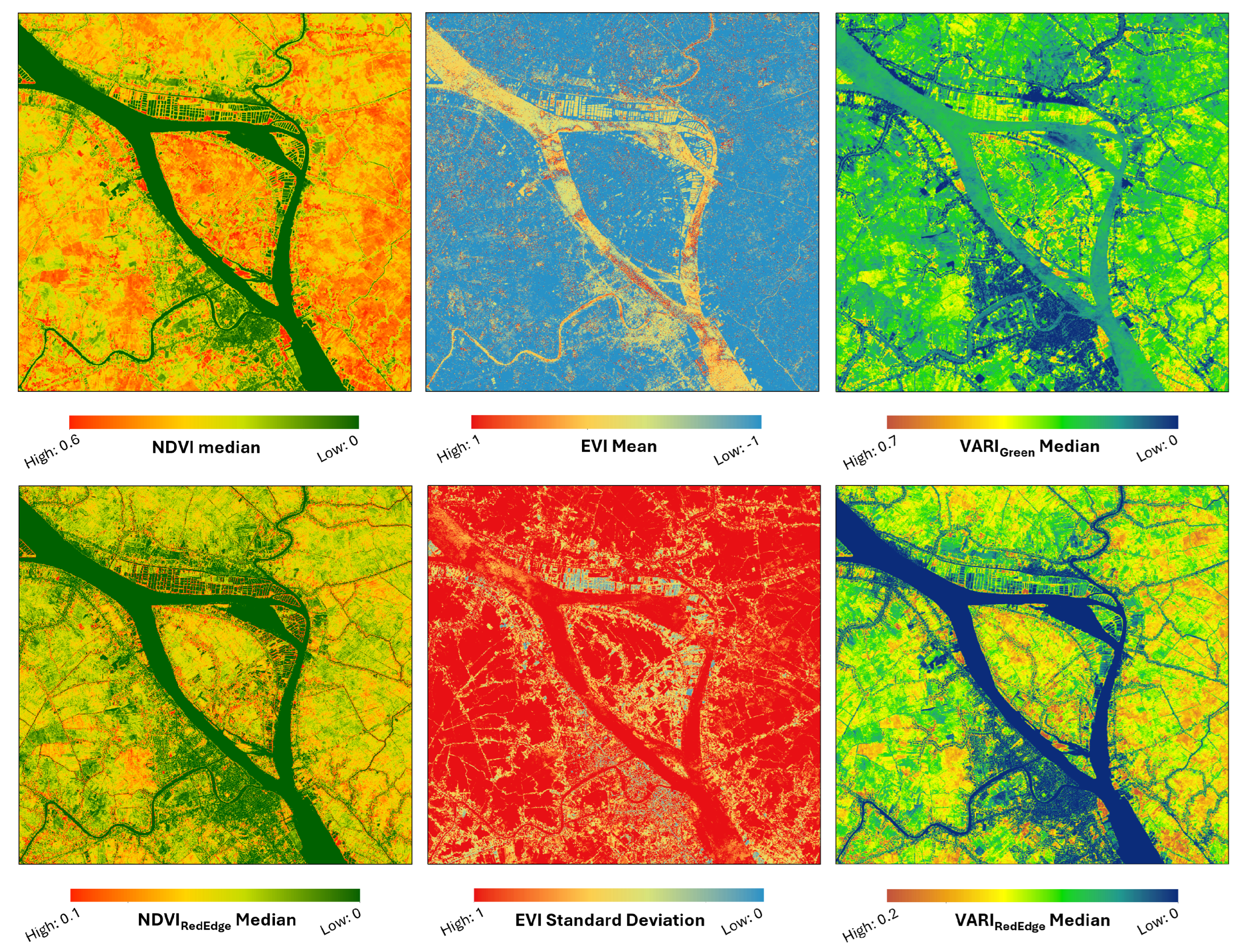
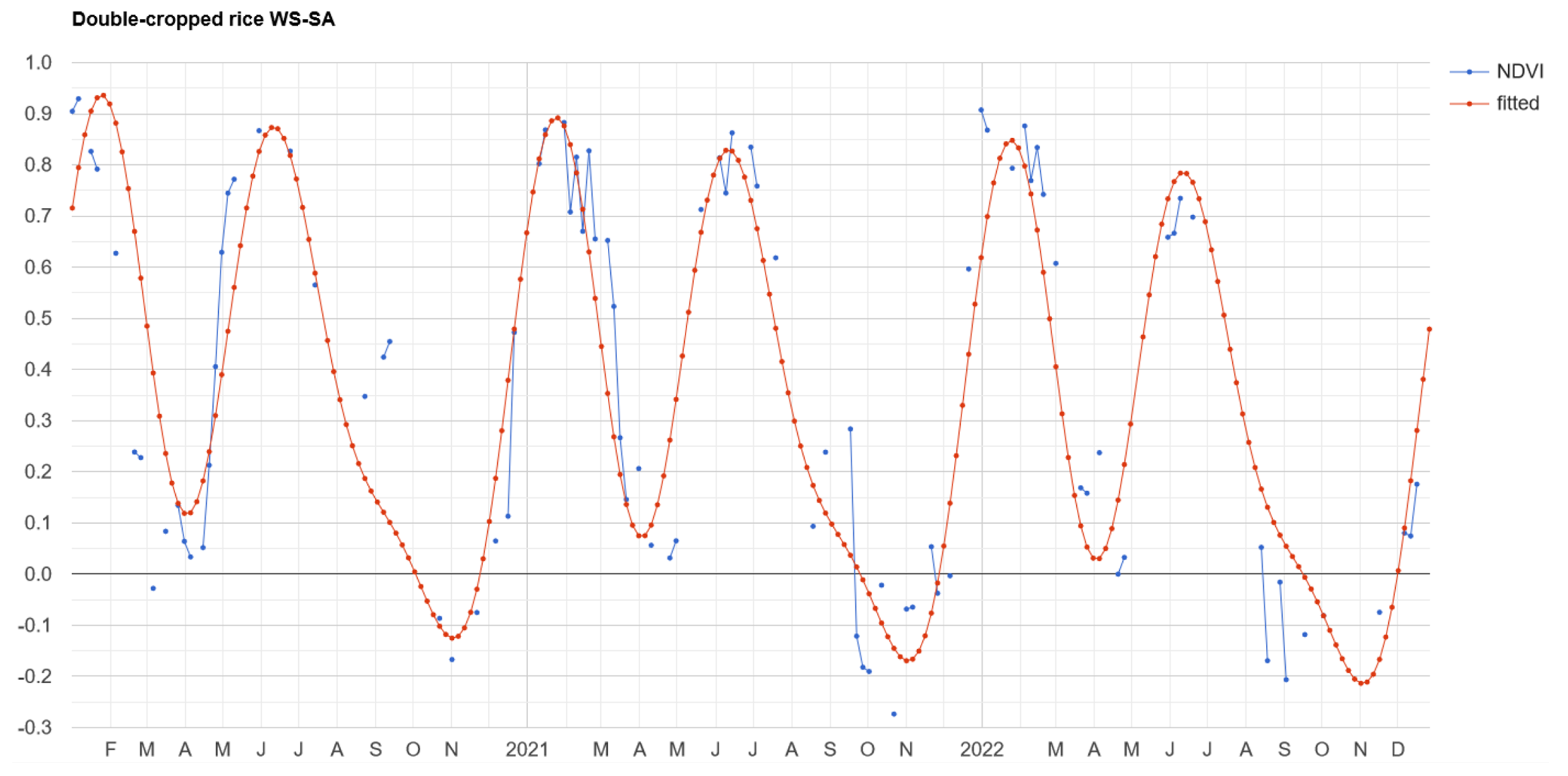

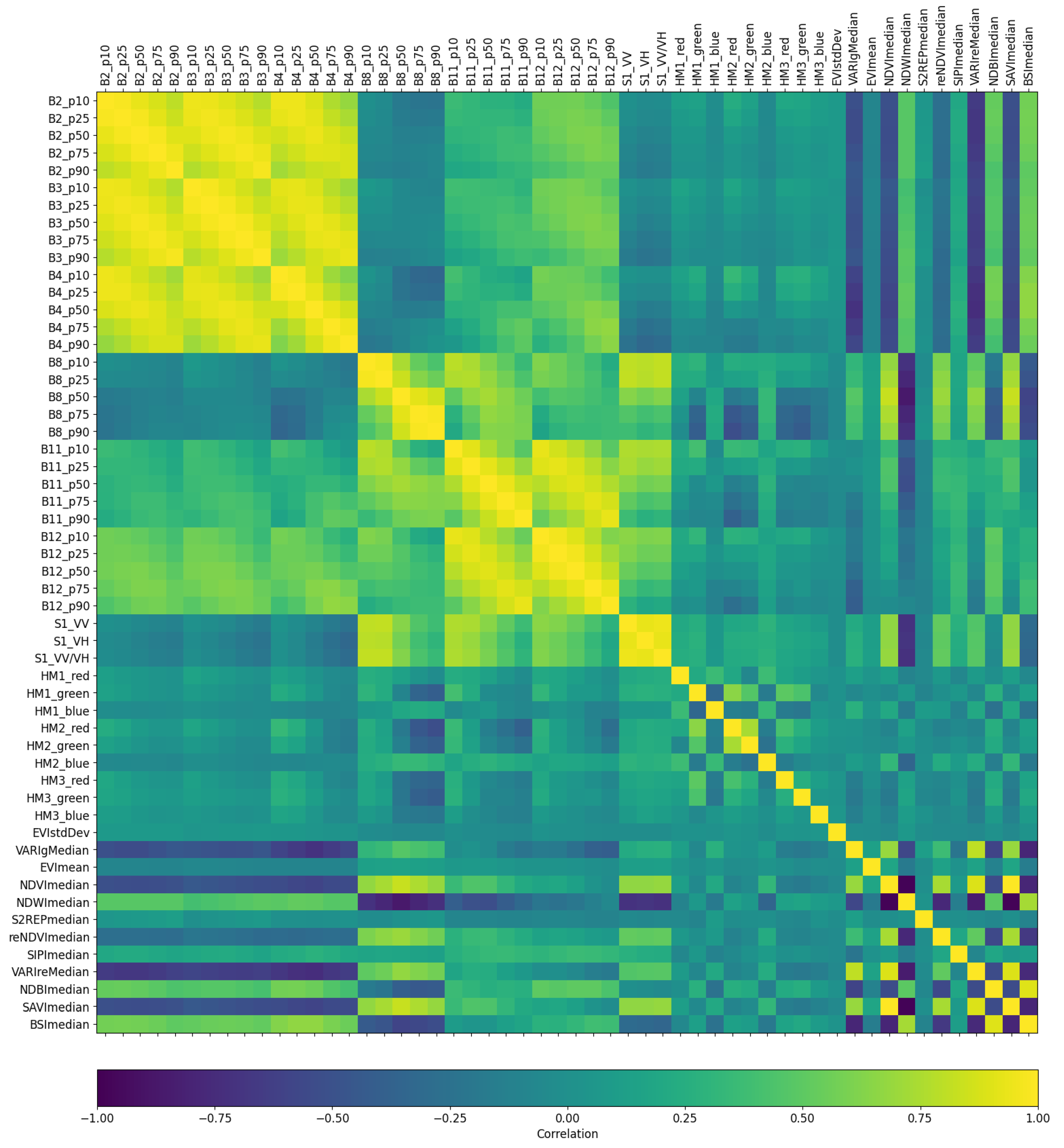
| Sentinel-2 | Sentinel-1 | |
|---|---|---|
| Sensor Type | Passive optical | Active radar |
| Aqcuisition mode | - | IWS |
| Spatial resolution | 10–60 m | 10 m |
| Polarisation | - | Single (VV,VH), Dual (VV-VH) |
| Pre-processing | Level-2A harmonized (BOA) | Level-1 GRD |
| Temporal resolution | 5 days | 6 days |
| Time period | 1 January 2021–31 December 2023 | 1 January 2021–31 December 2023 |
| Image count | 3047 | 1013 |
| Product size | 500 MB | 1 GB |
| Data volume | 1.5 TB | 1.1 TB |
| Spectral/SAR Features | Statistical Parameters | Purpose |
|---|---|---|
| Blue, green, red, NIR, SWIR1, SWIR2 | 10th, 25th, 50th, 75th, and 90th quantiles | Wide range of temporally focused spectral information for vegetation seasonality |
| First, second, and third terms from NDVI harmonic analysis | Amplitude, Phase | Rice seasonality |
| S1 backscatter dual polarization VV-VH; S1 backscatter single polarization VV, VH | Mean | Gap-filling of areas with low image per-pixel count (cloud independence); different backscatter behavior of vegetation |
| Normalized Difference Vegetation Index (NDVI) [89] | Median | Capturing of broad dividable vegetation spectrum in the MRD |
| NDVIRed Edge [90,91] | Median | Sensitivity for time-dependent density differences (e.g., harvest) |
| Enhanced Vegetation Index (EVI) [61] | Mean | Differentiation between aquacultural ponds and other water bodies |
| EVI | Standard Deviation | Capture variability of rice fields being systematically flooded and vegetated |
| Visible Atmospherically Resistant Index (VARIGreen and VARIRed Edge) [87] | Median | Vegetation fraction and leaf area later in growing season; close distances between different cropping patterns; spectrally confusing overlaps; rice-pattern dynamics |
| Structure Insensitive Pigment Index (SIPI) [88] | Median | Temporally dynamic vegetation: sensitivity to the ratio of bulk carotenoids to chlorophyll |
| Sentinel-2 Red Edge Position (S2REP) [92] | Median | Sensitive to changes in chlorophyll concentration |
| Normalized Difference Built-up Index (NDBI) [82] | Median | Urban structures |
| Normalized Difference Water Index (NDWI) [93] | Median | Water bodies |
| Class | Description | Training/Validation Samples |
|---|---|---|
| Water bodies | All water bodies, including rivers, lakes, canals, sea water, excluding aquaculture | 50/21 |
| Urban/Settlements | Human settlements: urban areas, villages, lakeside dwellings | 50/22 |
| Mangroves | Halophytes adapted to the brackish saline conditions in tropical coastal regions | 50/10 |
| Evergreen Forest | Evergreen broadleaf forest, wood- and shrubland | 50/44 |
| Melaleuca Forest | Seasonally flooded forest with Melaleuca cajuputi as dominant species | 50/28 |
| Casuarina | Evergreen shrubs and trees on low-fertility coastal sands | 24/16 |
| Aquaculture | Shrimp and fish farming, also salt cultivation | 50/42 |
| Double-cropped Rice SA-AW | Double-season rice usually cultivated between April and August (Summer–Autumn) and August and January (Autumn–Winter) | 60/20 |
| Double-cropped Rice WS-SA | Double-season rice usually cultivated between November and May (Winter–Spring) and April and August (Summer–Autumn) | 60/47 |
| Triple-cropped Rice | Triple-season rice usually cultivated in all three seasons (WS-SA-AW) | 60/99 |
| Aquaculture/Rice alternating | Alternating cultivation of aquaculture (primarily shrimp) and single season rice usually cultivated between August and January (Autumn–Winter) | 50/43 |
| Upland Crops/Rice alternating | Alternating cultivation of upland crops and single season rice | 30/20 |
| Vegetables | Cultivated taro, lotus, and counting | 50/11 |
| Orchards, Tree Crops | Cultivated durian, mandarin, longan, mango, orange, pummelo, rambutan, banana, avocado, mangosteen, jujube, acerola, eggplant, papaya, and counting | 50/116 |
| Pineapple, Coconut | Cultivated pineapple and coconut tree crops | 40/20 |
| Sugarcane | Cultivated sugarcane | 50/25 |
| Dragon Fruit | Cultivated dragon fruit | 50/14 |
| Water Melon | Cultivated water melon | 40/15 |
Disclaimer/Publisher’s Note: The statements, opinions and data contained in all publications are solely those of the individual author(s) and contributor(s) and not of MDPI and/or the editor(s). MDPI and/or the editor(s) disclaim responsibility for any injury to people or property resulting from any ideas, methods, instructions or products referred to in the content. |
© 2024 by the authors. Licensee MDPI, Basel, Switzerland. This article is an open access article distributed under the terms and conditions of the Creative Commons Attribution (CC BY) license (https://creativecommons.org/licenses/by/4.0/).
Share and Cite
Kupfer, N.; Vo, T.Q.; Bachofer, F.; Huth, J.; Vereecken, H.; Weihermüller, L.; Montzka, C. Enhanced Monitoring of Sub-Seasonal Land Use Dynamics in Vietnam’s Mekong Delta through Quantile Mapping and Harmonic Regression. Remote Sens. 2024, 16, 3569. https://doi.org/10.3390/rs16193569
Kupfer N, Vo TQ, Bachofer F, Huth J, Vereecken H, Weihermüller L, Montzka C. Enhanced Monitoring of Sub-Seasonal Land Use Dynamics in Vietnam’s Mekong Delta through Quantile Mapping and Harmonic Regression. Remote Sensing. 2024; 16(19):3569. https://doi.org/10.3390/rs16193569
Chicago/Turabian StyleKupfer, Nick, Tuan Quoc Vo, Felix Bachofer, Juliane Huth, Harry Vereecken, Lutz Weihermüller, and Carsten Montzka. 2024. "Enhanced Monitoring of Sub-Seasonal Land Use Dynamics in Vietnam’s Mekong Delta through Quantile Mapping and Harmonic Regression" Remote Sensing 16, no. 19: 3569. https://doi.org/10.3390/rs16193569
APA StyleKupfer, N., Vo, T. Q., Bachofer, F., Huth, J., Vereecken, H., Weihermüller, L., & Montzka, C. (2024). Enhanced Monitoring of Sub-Seasonal Land Use Dynamics in Vietnam’s Mekong Delta through Quantile Mapping and Harmonic Regression. Remote Sensing, 16(19), 3569. https://doi.org/10.3390/rs16193569








